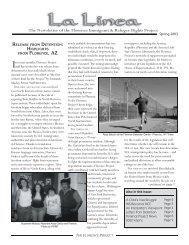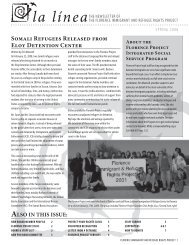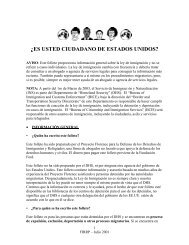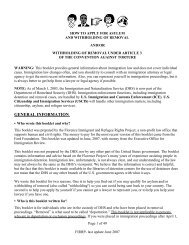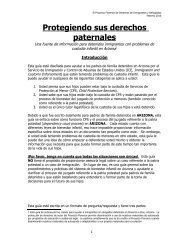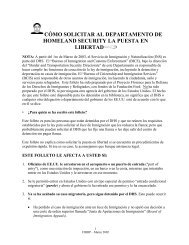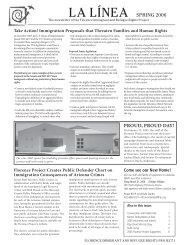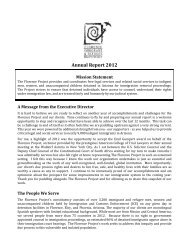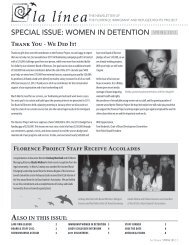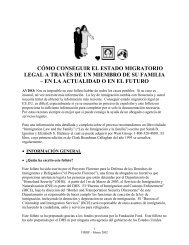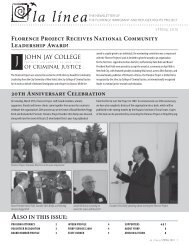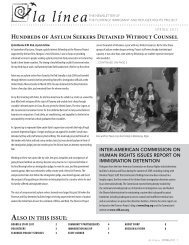quick reference chart and annotations for determining immigration ...
quick reference chart and annotations for determining immigration ...
quick reference chart and annotations for determining immigration ...
Create successful ePaper yourself
Turn your PDF publications into a flip-book with our unique Google optimized e-Paper software.
Immigrant Legal Resource Center, Florence Immigrant <strong>and</strong> Refugee Rights Project,<br />
Maricopa County Public Defender August 2012<br />
the person's driver license or privilege to drive as a result of violating section 28-1381 or 28-1382 or<br />
under section 28-1385.<br />
2. Within a period of sixty months commits a third or subsequent violation of section 28-1381, section<br />
28-1382 or this section or is convicted of a violation of section 28-1381, section 28-1382 or this section<br />
<strong>and</strong> has previously been convicted of any combination of convictions of section 28-1381, section 28-1382<br />
or this section or acts in another jurisdiction that if committed in this state would be a violation of section<br />
28-1381, section 28-1382 or this section.<br />
3. While a person under fifteen years of age is in the vehicle, commits a violation of either: (a) Section<br />
28-1381 or (b) Section 28-1382.<br />
4. While the person is ordered by the court or required pursuant to section 28-3319 by the department to<br />
equip any motor vehicle the person operates with a certified ignition interlock device, does either of the<br />
following: (a) While under arrest refuses to submit to any test chosen by a law en<strong>for</strong>cement officer<br />
pursuant to section 28-1321, subsection A; (b) Commits a violation of section 28-1381, section 28-1382<br />
or this section.<br />
Crime Involving Moral Turpitude (CMT):<br />
A1. Yes, if the record of conviction or other documents (including police reports) reflect that<br />
defendant was driving. Marmolejo-Campos v. Holder, 558 F.3d 903 (9th Cir. 2009) (en banc). The<br />
offense may not be a CMT if the record indicates or leaves open the possibility that the defendant was<br />
merely in physical control of the vehicle (e.g., sitting in a parked car), as opposed to driving it. See<br />
Hern<strong>and</strong>ez-Martinez v. Ashcroft, 329 F.3d 1117, 1118 (9th Cir. 2003). There<strong>for</strong>e counsel should attempt<br />
to have the record indicate, or leave open the possibility, that this was the case.<br />
There may also be an argument that, in order to be a CMT, the evidence must demonstrate that<br />
defendant “actually knew” (rather than “should have known”) that his license was suspended.<br />
Marmolejo-Campos v. Holder, 558 F.3d at 912. For instance, under Arizona law, mailing notice of<br />
suspension or revocation of a license to the defendant’s last known address satisfies the “should have<br />
known” statutory element. State v. Gonzales, 206 Ariz. 469, 471 (2007). However, <strong>immigration</strong> counsel<br />
can argue that the Arizona definition of “should have known” is analogous to a mens rea of negligence,<br />
which is not sufficient <strong>for</strong> a CMT. State v. Hyde, 921 P.2d 655, 678 (Ariz. 1996); Perez-Contreras, 20<br />
I&N Dec. 615, 618-19 (BIA 1992). Counsel should try to avoid pleading to actual knowledge that<br />
defendant knew her license had been suspended, canceled, revoked, or refused.<br />
A2. Not a CMT. Matter of Torres-Varela, 23 I. & N. Dec. 78 (BIA 2001) (conviction under A2,<br />
aggravated driving with prior DUI convictions, is not a CMT because no culpable mental state is<br />
required; repeated commission of a non-CMT does not constitute a CMT).<br />
A3. While this subsection does not have a mens rea sufficient to be a CMT, in practice, many<br />
<strong>immigration</strong> judges are finding it to be. Counsel should conservatively assume that it will be found a<br />
CMT. (See also “Other Grounds”).<br />
A4. Maybe. While there is no case law on point, ICE may argue that the “knowing” element <strong>for</strong><br />
this subsection is similar to that of A1 <strong>and</strong> that the offense is there<strong>for</strong>e a CMT. Counsel can argue that<br />
the subsection is more akin to A2 since no culpable mental state is required but should conservatively<br />
assume that it will be found a CMT.<br />
Aggravated Felony: Not under current law, but counsel should attempt to get a sentence of 364<br />
days or less. See § 28-1382, supra.<br />
Arizona Criminal Chart with Explanatory Endnote – August 2012<br />
104



